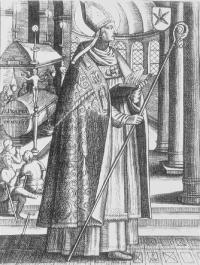|
Wreath
A wreath () is an assortment of flowers, leaves, fruits, twigs, or various materials that is constructed to form a circle . In English-speaking countries, wreaths are used typically as household ornaments, most commonly as an Advent and Christmas decoration. They are also used in ceremonial events in many cultures around the globe. They can be worn as a chaplet around the head, or as a garland around the neck. Etymology The word ''wreath'' comes from Middle English ''wrethe'' and from Old English ''writha'' 'band'. History Ancient Etruscan wreaths Wreaths were a design used in ancient times in southern Europe. The most well-known are pieces of Etruscan civilization jewelry, made of gold or other precious metals. Symbols from Greek myths often appear in the designs, embossed in precious metal at the ends of the wreath. Ancient Roman writers referred to Etruscan ''corona sutilis'', which were wreaths with their leaves sewn onto a background. These wreaths resemble a ... [...More Info...] [...Related Items...] OR: [Wikipedia] [Google] [Baidu] |
Laurel Wreath
A laurel wreath is a round wreath made of connected branches and leaves of the bay laurel (), an aromatic broadleaf evergreen, or later from spineless butcher's broom (''Ruscus hypoglossum'') or cherry laurel (''Prunus laurocerasus''). It is a symbol of triumph and is worn as a chaplet around the head, or as a garland around the neck. The symbol of the laurel wreath traces back to Ancient Greece. In Greek mythology, the god Apollo, who is patron of lyrical poetry, musical performance and skill-based athletics, is conventionally depicted wearing a laurel wreath on his head in all three roles. Wreaths were awarded to victors in athletic competitions, including the ancient Olympics; for victors in athletics they were made of wild olive tree known as ''" kotinos"'' (), (sc. at Olympia) – and the same for winners of musical and poetic competitions. In Rome they were symbols of martial victory, crowning a successful commander during his triumph. Whereas ancient laurel wreaths are mos ... [...More Info...] [...Related Items...] OR: [Wikipedia] [Google] [Baidu] |
Advent
Advent is a Christian season of preparation for the Nativity of Christ at Christmas. It is the beginning of the liturgical year in Western Christianity. The name was adopted from Latin "coming; arrival", translating Greek ''parousia''. In the New Testament, this is the term used for the Second Coming of Christ. Thus, the season of Advent in the Christian calendar anticipates the "coming of Christ" from three different perspectives: the physical nativity in Bethlehem, the reception of Christ in the heart of the believer, and the eschatological Second Coming. Practices associated with Advent include Advent calendars, lighting an Advent wreath, praying an Advent daily devotional, erecting a Christmas tree or a Chrismon tree, lighting a Christingle, as well as other ways of preparing for Christmas, such as setting up Christmas decorations, a custom that is sometimes done liturgically through a hanging of the greens ceremony. The equivalent of Advent in Eastern Christianity is ... [...More Info...] [...Related Items...] OR: [Wikipedia] [Google] [Baidu] |
Christmas Decoration
A Christmas decoration is any of several types of ornamentation used at Christmastide and the greater holiday season. The traditional colors of Christmas are pine green (evergreen), snow white, and heart red. Gold and silver are also very common, as are other metallic colours. Typical images on Christmas decorations include Baby Jesus, Father Christmas, Santa Claus, and the star of Bethlehem. In many countries, such as Sweden, people start to set up their Advent and Christmas decorations on the Advent Sunday, first day of Advent. Christian liturgy, Liturgically, this is done in some parish church, parishes through a Hanging of the Greens ceremony. In the Western Christian world, the two traditional days when Christmas decorations are removed are Twelfth Night (holiday), Twelfth Night and if they are not taken down on that day, Candlemas, the latter of which ends the Epiphanytide, Christmas-Epiphany season in some Christian denominations, denominations. Taking down Christmas ... [...More Info...] [...Related Items...] OR: [Wikipedia] [Google] [Baidu] |
Etruscan Civilization
The Etruscan civilization () was developed by a people of Etruria in ancient Italy with a common language and culture who formed a federation of city-states. After conquering adjacent lands, its territory covered, at its greatest extent, roughly what is now Tuscany, western Umbria, and northern Lazio, as well as what are now the Po Valley, Emilia-Romagna, south-eastern Lombardy, southern Veneto, and western Campania. The earliest evidence of a culture that is identifiably Etruscan dates from about 900BC. This is the period of the Iron Age Villanovan culture, considered to be the earliest phase of Etruscan civilization, which itself developed from the previous late Bronze Age Proto-Villanovan culture in the same region. Etruscan civilization endured until it was assimilated into Roman society. Assimilation began in the late 4thcenturyBC as a result of the Roman–Etruscan Wars; it accelerated with the grant of Roman citizenship in 90 BC, and became complete in 27 BC, when the Etr ... [...More Info...] [...Related Items...] OR: [Wikipedia] [Google] [Baidu] |
Chalking The Door
Chalking the door is one of the Christian Epiphanytide traditions used to bless one's home. Epiphany Either on Twelfth Night (5 January), the twelfth day of Christmastide and eve of the feast of the Epiphany, or on Epiphany Day (6 January) itself, many Christians (including Anglicans, Lutherans, Methodists, Presbyterians and Roman Catholics, among others) write on their doors or lintels with chalk in a pattern such as "20 ✝ C ✝ M ✝ B ✝ ". The numbers in this example refer to the calendar year and the crosses to Christ. The letters C, M, and B stand for the traditional names of the Magi (Caspar, Melchior and Balthazar), or alternatively for the Latin blessing ('May Christ bless this house'). Another form, for Three Kings day, is to mark the door with "IIIK" (the Roman numeral three followed by "K" for "Kings"). Chalking the door is done most commonly on Epiphany Day itself. However, it can be done on any day of the Epiphany season. In some localitie ... [...More Info...] [...Related Items...] OR: [Wikipedia] [Google] [Baidu] |
Christmas Wreath - Geograph
Christmas is an annual festival commemorating the birth of Jesus Christ, observed primarily on December 25 as a religious and cultural celebration among billions of people around the world. A feast central to the Christian liturgical year, it is preceded by the season of Advent or the Nativity Fast and initiates the season of Christmastide, which historically in the West lasts twelve days and culminates on Twelfth Night. Christmas Day is a public holiday in many countries, is celebrated religiously by a majority of Christians, as well as culturally by many non-Christians, and forms an integral part of the holiday season organized around it. The traditional Christmas narrative recounted in the New Testament, known as the Nativity of Jesus, says that Jesus was born in Bethlehem, in accordance with messianic prophecies. When Joseph and Mary arrived in the city, the inn had no room and so they were offered a stable where the Christ Child was soon born, with angels proclaiming ... [...More Info...] [...Related Items...] OR: [Wikipedia] [Google] [Baidu] |
Twig
A twig is a thin, often short, branch of a tree or bush. The buds on the twig are an important diagnostic characteristic, as are the abscission scars where the leaves have fallen away. The color, texture, and patterning of the twig bark are also important, in addition to the thickness and nature of any pith of the twig. There are two types of twig: vegetative twigs and fruiting spurs. Fruiting spurs are specialized twigs that generally branch off the sides of branches and are stubby and slow-growing, with many annular ring markings from seasons past. The age and rate of growth of a twig can be determined by counting the winter terminal bud scale scars, or annular ring marking, down the length of the twig. Twigs can be useful in starting fire. They can be used as kindling wood, bridging the gap between highly flammable tinder (dry grass and leaves) and firewood Firewood is any wooden material that is gathered and used for fuel. Generally, firewood is not highly proces ... [...More Info...] [...Related Items...] OR: [Wikipedia] [Google] [Baidu] |
Peneus
In Greek mythology, Peneus (; Ancient Greek: Πηνειός) was a Thessalian river god, one of the three thousand Rivers (Potamoi), a child of Oceanus and Tethys. Family The nymph Creusa bore him one son, Hypseus, who was King of the Lapiths, and three daughters, Menippe (mother of Phrastor by Pelasgus), Daphne and Stilbe.Diodorus Siculus, 4.69.1 Some sources state that he was the father of Cyrene, alternately known as his granddaughter through Hypseus. Daphne, in an Arcadian version of the myth, was instead the daughter of the river god Ladon. Peneus also had a son Atrax with Bura, and Andreus with an unknown consort. Tricce (or Tricca), eponym of the city Tricca, was mentioned as his daughter. In later accounts, Peneus was credited to be the father of Chrysogenia who consorted with Zeus and became the mother of Thissaeus.Pseudo-Clement, '' Recognitions'' 10.21-23 Meanwhile, his daughter Astabe coupled with Hermes and became the parents of Astacus, father of Iocles, ... [...More Info...] [...Related Items...] OR: [Wikipedia] [Google] [Baidu] |
Flower
A flower, sometimes known as a bloom or blossom, is the reproductive structure found in flowering plants (plants of the division Angiospermae). The biological function of a flower is to facilitate reproduction, usually by providing a mechanism for the union of sperm with eggs. Flowers may facilitate outcrossing (fusion of sperm and eggs from different individuals in a population) resulting from cross-pollination or allow selfing (fusion of sperm and egg from the same flower) when self-pollination occurs. There are two types of pollination: self-pollination and cross-pollination. Self-pollination occurs when the pollen from the anther is deposited on the stigma of the same flower, or another flower on the same plant. Cross-pollination is when pollen is transferred from the anther of one flower to the stigma of another flower on a different individual of the same species. Self-pollination happens in flowers where the stamen and carpel mature at the same time, and are positi ... [...More Info...] [...Related Items...] OR: [Wikipedia] [Google] [Baidu] |
Christianity
Christianity is an Abrahamic monotheistic religion based on the life and teachings of Jesus of Nazareth. It is the world's largest and most widespread religion with roughly 2.38 billion followers representing one-third of the global population. Its adherents, known as Christians, are estimated to make up a majority of the population in 157 countries and territories, and believe that Jesus is the Son of God, whose coming as the messiah was prophesied in the Hebrew Bible (called the Old Testament in Christianity) and chronicled in the New Testament. Christianity began as a Second Temple Judaic sect in the 1st century Hellenistic Judaism in the Roman province of Judea. Jesus' apostles and their followers spread around the Levant, Europe, Anatolia, Mesopotamia, the South Caucasus, Ancient Carthage, Egypt, and Ethiopia, despite significant initial persecution. It soon attracted gentile God-fearers, which led to a departure from Jewish customs, and, a ... [...More Info...] [...Related Items...] OR: [Wikipedia] [Google] [Baidu] |
Angel Gabriel
In Abrahamic religions (Judaism, Christianity and Islam), Gabriel (); Greek: grc, Γαβριήλ, translit=Gabriḗl, label=none; Latin: ''Gabriel''; Coptic: cop, Ⲅⲁⲃⲣⲓⲏⲗ, translit=Gabriêl, label=none; Amharic: am, ገብርኤል, translit=Gabrəʾel, label=none; arc, ܓ݁ܰܒ݂ܪܺܝܐܝܶܠ, translit=Gaḇrīʾēl; ar, جِبْرِيل, Jibrīl, also ar, جبرائيل, Jibrāʾīl or ''Jabrāʾīl'', group="N" is an archangel with power to announce God's will to men. He is mentioned in the Hebrew Bible, the New Testament, and the Quran. Many Christian traditions — including Anglicanism, Eastern Orthodoxy, and Roman Catholicism — revere Gabriel as a saint. In the Hebrew Bible, Gabriel appears to the prophet Daniel to explain his visions (Daniel 8:15–26, 9:21–27). The archangel also appears in the Book of Enoch and other ancient Jewish writings not preserved in Hebrew. Alongside the archangel Michael, Gabriel is described as the guardian angel of ... [...More Info...] [...Related Items...] OR: [Wikipedia] [Google] [Baidu] |
Leaf
A leaf ( : leaves) is any of the principal appendages of a vascular plant stem, usually borne laterally aboveground and specialized for photosynthesis. Leaves are collectively called foliage, as in "autumn foliage", while the leaves, stem, flower, and fruit collectively form the shoot system. In most leaves, the primary photosynthetic tissue is the palisade mesophyll and is located on the upper side of the blade or lamina of the leaf but in some species, including the mature foliage of ''Eucalyptus'', palisade mesophyll is present on both sides and the leaves are said to be isobilateral. Most leaves are flattened and have distinct upper (adaxial) and lower ( abaxial) surfaces that differ in color, hairiness, the number of stomata (pores that intake and output gases), the amount and structure of epicuticular wax and other features. Leaves are mostly green in color due to the presence of a compound called chlorophyll that is essential for photosynthesis as it absorbs light ... [...More Info...] [...Related Items...] OR: [Wikipedia] [Google] [Baidu] |


.jpg)


.jpg)


.jpg)
.png)